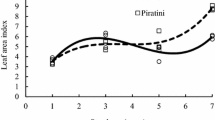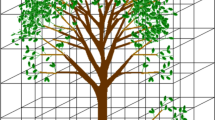Abstract
Solar radiation transmission in forest stands affects many processes, including biomass and diversity of understorey vegetation and tree seedling regeneration (growth and morphogenesis). However, understorey light availability is not easy for forest managers or scientists to measure. Therefore, different models have been developed to predict light transmission in forest stands according to tree or stand structure. However, these models are generally too complex to be used operationally. This paper reports the assessment of light transmission according to stand parameters commonly measured by foresters in inventories. We measured transmittance in 29 even-aged oak stands in France for various wavebands, total solar radiation (TSR, 300–3000 nm), PAR (400–700 nm), red (R, 660 nm) and far-red (FR, 730 nm), and demonstrated that transmittance in a given waveband can be predicted from the measurement of another waveband. The R:FR ratio can be predicted according to TSR or PAR transmittance, but the opposite is also true; PAR or TSR transmittance can be predicted from the R:FR ratio. Transmittance variability was characterised, and the variation coefficient ranged from 5 to 45% with a trend to increase with tree density. By analogy to Beer–Lambert's law, we established that mean daily transmittance for the different wavebands can be assessed according to stand basal area and stand age with good accuracy (R 2>0.74). Results are discussed in comparison with other models based on the principle of parsimony.






Similar content being viewed by others
References
Ammer C (2003) Growth and biomass partitioning of Fagus sylvatica L. and Quercus robur L; seedlings in response to shading and small changes in the R/FR-ratio of radiation. Ann For Sci 60:163–171
Aphalo PJ, Lehto T (2001) Effect of lateral far-red light supplementation on the growth and morphology of birch seedlings and its interaction with mineral nutrition. Trees 15:297–303
Avalos G, Mulkey SS, Kitajima K (1999) Leaf optical properties of trees and lianas in outer canopy of tropical dry forest. Biotropica 31:517–520
Balandier P, Ruchaud F, Pauwels D, Jouvie R (2002) Predicting light transmission through canopies of larch stands (Larix sp.) in France and Belgium. In: Pâques LE (ed) Improvement of larch (Larix sp.) for better growth, stem form and wood quality. INRA – Cemagref, France, pp 340–349
Baldocchi D, Collineau S (1994) The physical nature of solar radiation in heterogeneous canopies: spatial and temporal attributes. In: Caldwell MM, Pearcy RW (eds) Exploitation of environmental heterogeneity by plants. Academic Press, San Diego, California, pp 21–71
Bary-Lenger A, Nebout JP (1993) Les chênes pédonculé et sessile en France et en Belgique. Perron Editions, Alleur-Liège, Belgium
Beaudet M, Messier C, Canham CD (2002) Prediction of understorey light conditions in northern hardwood forests following parameterization, sensitivity analysis, and tests of the SORTIE light model. For Ecol Manage 165:235–248
Bréda N (1999) L'indice foliaire des couverts forestiers: mesure, variabilité et rôle fonctionnel. Rev For Fr 60:135–150
Bréda N (2003) Ground-based measurements of leaf area index: a review of methods, instruments and current controversies. J Exp Bot 54:2403–2417
Brown MJ, Parker GG (1994) Canopy light transmittance in a chronosequence of mixed-species deciduous forests. Can J For Res 28:1694–1703
Brown N, Jennings S, Wheeler P, Nabe-Nielsen J (2000) An improved method for the rapid assessment of forest understorey light environments. J Appl Ecol 37:1044–1053
Brunner A (1998) A light model for spatially explicit forest stand models. For Ecol Manage 107:19–46
Canham CD, Coates KD, Bartemucci P, Quaglia S (1999) Measurement and modeling of spatially explicit variation in light transmission through interior cedar-hemlock forests of British Columbia. Can J For Res 29:1775–1783
Capers RS, Chazdon RL (2004) Rapid assessment of the understorey light availability in a wet tropical forest. Agric For Meteor 123:177–185
Collet C, Lanter O, Pardos M (2001) Effects of canopy opening on height and diameter growth in naturally regenerated beech seedlings. Ann For Sci 58:127–134
Collet C, Lanter O, Pardos M (2002) Effects of canopy opening on the morphology and anatomy of naturally regenerated beech seedlings. Trees 16:291–298
Comeau PG, Gendron F, Letchford T (1998) A comparison of several methods for estimating light under a paper birch mixedwood stand. Can J For Res 28:1843–1850
Comeau PG, Heineman JL (2003) Predicting understorey light microclimate from stand parameters in young paper birch (Betula papyrifera Marsh.) stands. For Ecol Manage 180:303–315
Groot A (2004) A model to estimate light interception by tree crowns, applied to black spruce. Can J For Res 34:788–799
Grubb PJ, Lee WG, Kollmann J, Wilson JB (1996) Interaction of irradiance and soil nutrient supply on growth of seedlings of ten European tall-shrub species and Fagus sylvatica. J Ecol 84:827–840
Huemmrich KF, Goward SN (1997) Vegetation canopy PAR absorptance and NDVI: an assessment for ten tree species with the SAIL model. Rem Sens Env 61:254–269
Hyer EJ, Goetz SJ (2004) Comparison and sensitivity analysis of instruments and radiometric methods for LAI estimation: assessments from a boreal forest site. Agric For Meteor 122:157–174
Jacquemoud S, Baret F (1990) PROSPECT: a model of leaf optical properties spectra. Rem Sen Env 34:75–91
Jennings SB, Brown ND, Sheil D (1999) Assessing forest canopies and understorey illumination: canopy closure, canopy cover and other measures. Forestry 72:59–73
Jonckheere I, Fleck S, Nackaerts K, Muys B, Coppin P, Weiss M, Baret F (2004) Review of methods for in situ leaf area index determination. Part I. Theories, sensors and hemispherical photography. Agric For Meteor 121:19–35
Kuusipalo J (1985) On the use of tree stand parameters in estimating light conditions below the canopy. Silva fenn 19:185–196
Lieffers VJ, Messier C, Stadt KJ, Gendron F, Comeau PG (1999) Predicting and managing light in the understorey of boreal forests. Can J For Res 29:796–811
Machado JL, Reich PB (1999) Evaluation of several measures of canopy openness as predictors of photosynthetic photon flux density in deeply shaded conifer-dominated forest understorey. Can J For Res 29:1438–1444
Mitchell JE, Popovich SJ (1997) Effectiveness of basal area for estimating canopy cover of ponderosa pine. For Ecol Manage 95:45–51
Montgomery RA, Chazdon RL (2002) Light gradient partitioning by tropical tree seedlings in the absence of canopy gaps. Oecologia 131:165–174
Mory A, Takeda H (2003) Light-related competitive effects of overstory trees on the understorey conifer saplings in a subalpine forest. J For Res 8:163–168
Pinno BD, Lieffers VJ, Stadt KJ (2001) Measuring and modelling the crown and light transmission characteristics of juvenile aspen. Can J For Res 31:1930–1939
Pooter L, Kwant R, Hernandez R, Medina E, Werger MJA (2000) Leaf optical properties in Venezuelan cloud forest trees. Tree Physiol 20:519–526
Rapparini F, Rotondi A, Baraldi R (1999) Blue light regulation of the growth of Prunus persica plants in a long term experiment: morphological and histological observations. Trees 14:169–176
Ricard JP, Messier C, Delagrange S, Beaudet M (2003) Do understorey sapling respond to both light and below-ground competition?: a field experiment in a north-eastern American hardwood forest and a literature review. Ann For Sci 60:749–756
Smith H (1995) Physiological and ecological function within the phytochrome family. Annu Rev Plant Physiol Plant Mol Biol 46:289–315
Sinoquet H, Varlet-Grancher C, Bonhomme R (1993) Modelling radiative transfer within homogenous canopies: basic concepts. In: Varlet-Grancher C, Bonhomme R, Sinoquet S (eds) Crop structure and light microclimate. INRA, Paris, France, pp 207–228
Shinozaki K, Yoda K, Hozumi K, Kira T (1964) A quantitative analysis of plant form – The pipe model theory. I. Basic analysis. Jpn J Ecol 14:97–104
Song C, Band LE (2004) MVP: a model to simulate the spatial patterns of photosynthetically active radiation under discrete forest canopies. Can J For Res 34:1192–1203
Sonohat G, Balandier P, Ruchaud F (2004) Predicting solar radiation transmittance in the understorey of even-aged coniferous stands in temperate forests. Ann For Sci 61:1–13
Valladares F, Chico JM, Aranda I, Balaguer L, Dizengremel P, Manrique E, Dreyer E (2002) The greater seedling high-light tolerance of Quercus robur over Fagus sylvatica is linked to a greater physiological plasticity. Trees 16:395–403
Wallace JS, Verhoef A (2000) Modelling interactions in mixed-plant communities: light, water and carbon dioxide. In: Marshall B, Roberts JA (eds) Leaf development and canopy growth. Sheffield Academic Press Ltd, Sheffield, England, pp 204–250
Waring RH, Schoeder PE, Oren R (1982) Application of the pipe model theory to predict canopy leaf area. Can J For Res 12:556–560
Weisberg PJ, Hadorn C, Bugmann H (2003) Predicting understorey vegetation cover from overstorey attributes in two temperate mountain forests. Forstw Cbl 122:273–286
Weiss M, Baret F, Smith GJ, Jonckheere I, Coppin P (2004) Review of methods for in situ leaf area index (LAI) determination. Part II. Estimation of LAI, errors and sampling. Agric For Meteor 121:37–53
Acknowledgements
This study was partially supported by the French Ministry of Agriculture. We thank René Jouvie, Christophe de Berranger, Janire Chirapozu and Sylvian Dever for their contribution to the project. We are also very grateful to the CRPF (Regional Centre for Private Forests) of the Auvergne region and particularly Jean Paul Nebout, and to the ONF (National Forest Office) and particularly Félix Ruchaud and Patrick Moreau, for their help on stand research and information.
Author information
Authors and Affiliations
Corresponding author
Additional information
Communicated by M. Küppers
Rights and permissions
About this article
Cite this article
Balandier, P., Sonohat, G., Sinoquet, H. et al. Characterisation, prediction and relationships between different wavebands of solar radiation transmitted in the understorey of even-aged oak (Quercus petraea, Q. robur) stands. Trees 20, 363–370 (2006). https://doi.org/10.1007/s00468-006-0049-3
Received:
Revised:
Accepted:
Published:
Issue Date:
DOI: https://doi.org/10.1007/s00468-006-0049-3




